
About a month ago, we received a call from one of our heat pump customers. She reported that the multi-head ductless system we had installed last November had heated well all winter but when she switched to air conditioning, she noticed a problem. Her husband’s office, on the top floor of their split-level home, wasn’t staying cool. Their bedroom suite, a floor below, was uncomfortably cold.
The technician we first sent to troubleshoot turned on the heads, both nominal 9000 Btu/h high-wall units. The heads responded as expected to the handheld remote controller and started blowing cool air. After performing a quick visual check, the tech reported that the system appeared to operate as it should.
A few weeks later, the customer called back with the same complaint. This time I decided to run the call myself to see if I could figure out what was going on. Troubleshooting ductless temperature control issues has become a passion of mine, and I wanted to get to the bottom of this situation.
Possible reasons for unexpected temperatures
As I drove to the house, I ran through a list of possible causes for the inadequate cooling in the study. Dirty filters could be reducing airflow; a refrigerant leak could be reducing cooling capacity; user behavior—for example, turning the system on and off frequently—could be preventing the extended run-times needed to cool and dehumidify the space.
Less likely but still possible were a host of mechanical issues: a kinked refrigerant line, a defective valve or thermistor, even a bad compressor. And in the back of my mind was the nagging fear that perhaps I had undersized the system. (In the world of heat pumps and air conditioning, oversizing is far more common—and creates far more problems—than undersizing. We perform thorough…
Weekly Newsletter
Get building science and energy efficiency advice, plus special offers, in your inbox.

This article is only available to GBA Prime Members
Sign up for a free trial and get instant access to this article as well as GBA’s complete library of premium articles and construction details.
Start Free TrialAlready a member? Log in














11 Comments
Thanks for the story, the lesson, and for thinking through the broader lessons. Indeed, "listen well" and "don't get your wires crossed" are lessons that apply much more broadly than just to this problem, or just to green building.
How is this not identified and solved upon installation? Shouldn’t there be some kind of standard commissioning of the system to verify that it’s running as expected/designed?
I’m told that I should have my hvac system inspected yearly - what’s the point of that if these details are missed by a reputable and fastidious installer?
I agree. Most of the issues we see with HVAC systems are due to unforced errors. The challenge is that, between a chronic labor shortage (affecting all the building trades), price pressures, and the randomness of external events (like weather and Covid), sometimes things slip through. This isn't to make excuses. I debated writing about this because I am actually a little embarrassed that it happened, but I'm trying to embrace transparency and make sure mistakes turn into learning opportunities. When I get a little time, I'd like to re-read "The Checklist Manifesto," which goes into lessons learned in error prevention in a medical context
You have done us all a favor by reporting this. The new HVAC systems are wonderful but very technical and there is opportunity for error in the installation. You got a clue from the homeowner that helped solve the problem, every once in a while things work out.
Follow Through !! Keep your eye on the target until the project is complete, many errors are made approaching the finish line.
Good for you, Jon. Turning mistakes into lessons shared is a triumph.
“[Deleted]”
This is a useful article . But the title is highly misleading , it creates the impression that mini splits in general fail to heat and cool properly when really you report an isolated problem that is almost surely unrepresentative. I would urge you to change the title .
If you disconnect the wires at each end, you could also use a "fox and hound" to verify which wire is which. Sometimes they are called "tone and probe" kits.
Thank you John for sharing the insight. Buildings are a complex things without the benefit of prototyping and testing associated with a final manufactured product. Each part is tested independently, but the difficulty is in how these components come together.
Thanks for sharing your experiences and knowledge on this. It looks like your check out to diagnose the issue could be translated into a fairly simple commissioning test for the installers. Our ducted mini-split system uses radio frequency controllers for each zone and I was able to verify signal demand and response through the last year of use. We have a Net Zero home that is connected to the grid for supplement and credits. The only issue we have for the HVAC is that the Mitsubishi units will not run on our emergency generator if the grid goes down. During the winter, not an issue as we can plug a couple of IR copper heaters into the wall outlets powered by the emergency generator. During the summer, it is open windows only if power generator goes on. Luckily, it gets cool here in NH in the evening. Thanks again.
The lesson is =- forgo mini splits- this article evinces the complexity of these units,e speciallly the install, and the very real risk of mis-sizing a unit. Just the fact that this technician/owner feels the desire(need ?) to become expert at :”ductless temperature control issues” on NEW units tells you all you need to know . I simply dont get the enthusiasm for mini splits, and unless you live in a uniform igloo with no windows or interior walls or large rooms, why are there so many mini split fanboys ? Its well known that most HVAC companies love to install hardware with the large margins; and hate to install ducts (esp correctly) but are mini split installs more lucrative than traditional HVAC central blowers ? More expensive (ESPecially in houses over 2000 sq feet requiring many heads and multiple units) ,, more Maintainence, more complex, useless in large rooms, oh and did I mention the interior units are truly UGLY and cheap looking ??
Log in or become a member to post a comment.
Sign up Log in